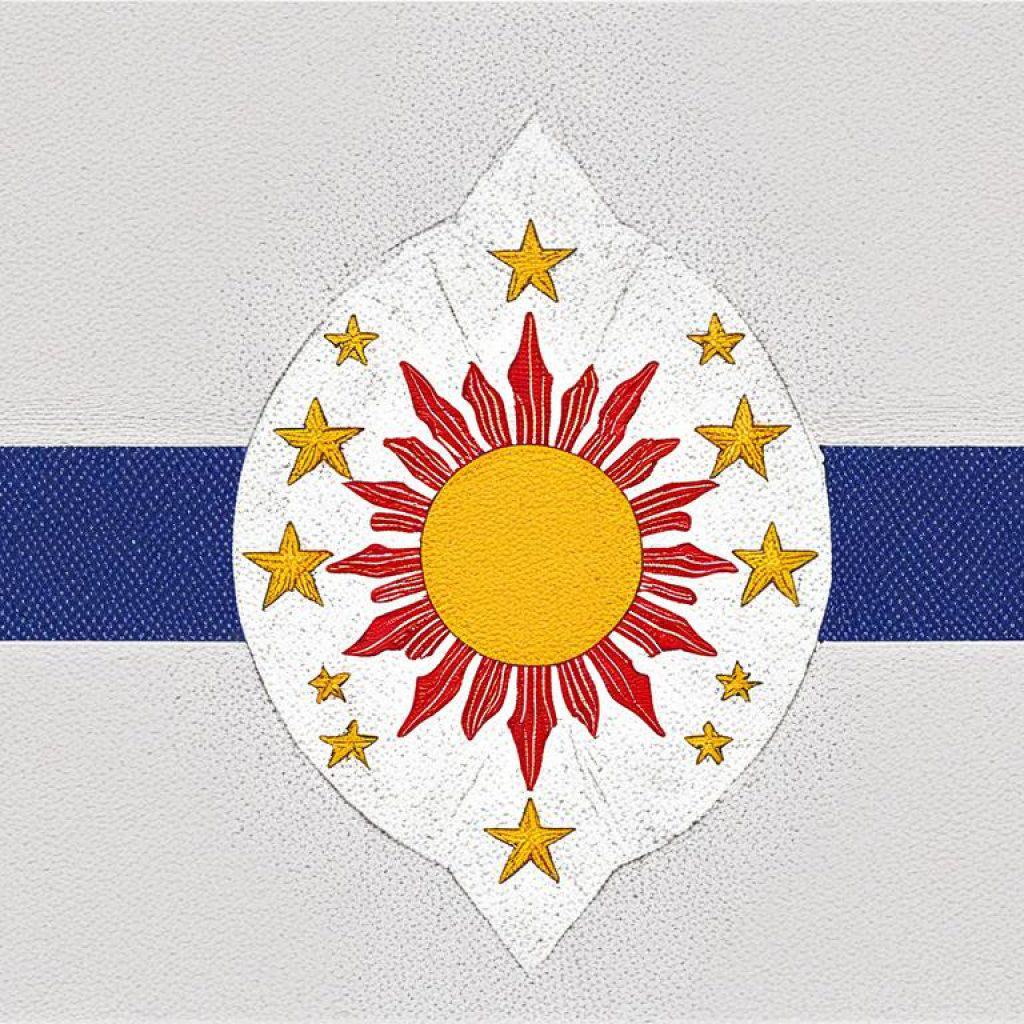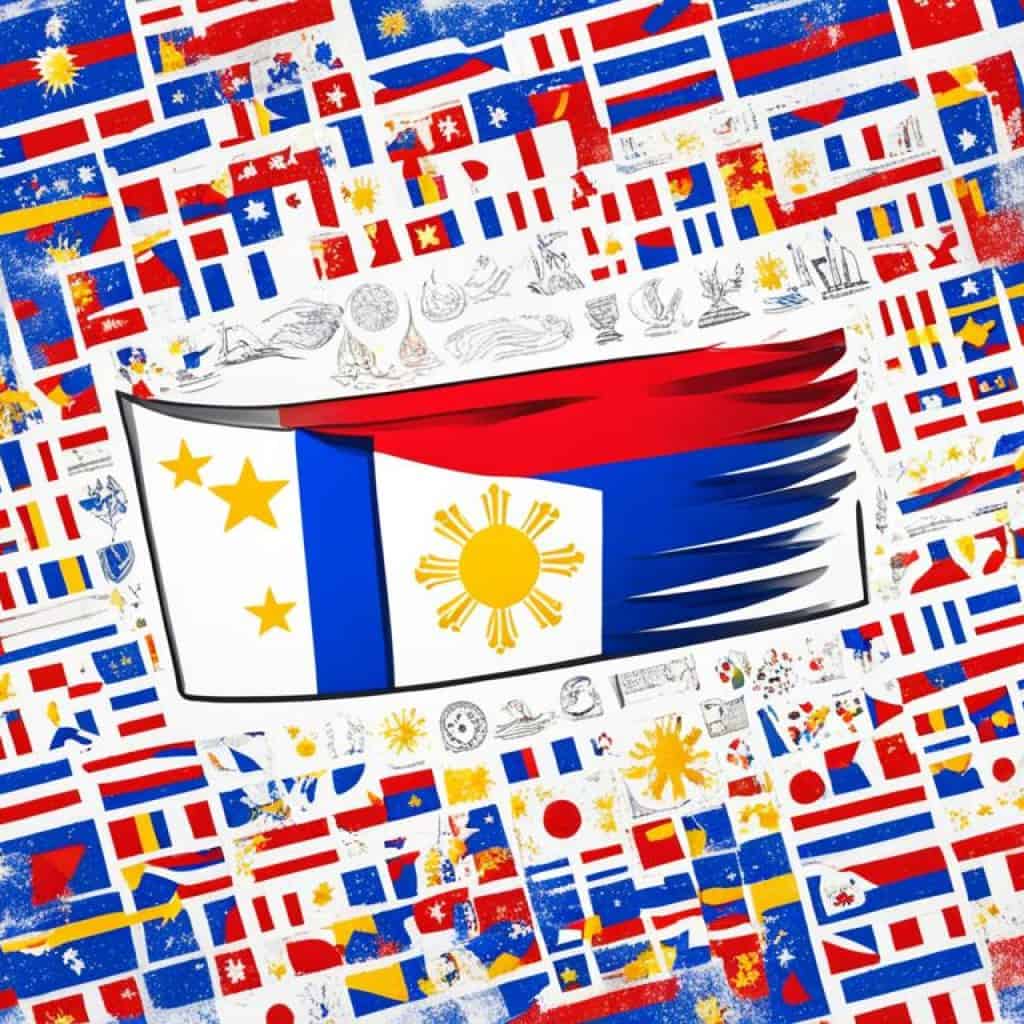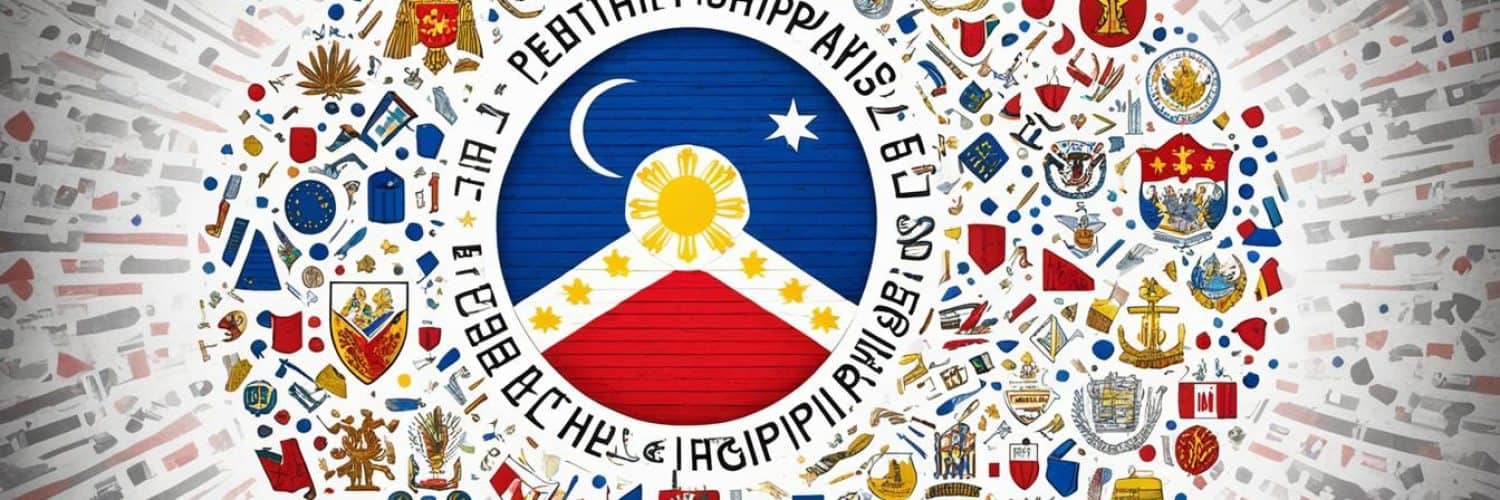Have you ever wondered about the proper way to display and handle the national flag of the Philippines? Are you curious about the symbolism behind its design and the significance of flag ceremonies? The Flag Heraldic Code of the Philippines, also known as Republic Act No. 8491, holds the answers to these questions and more. It provides comprehensive guidelines on the use and display of the national flag, anthem, and other heraldic items, reflecting the nation’s ideals and traditions. Let’s dive deep into the world of flag code Philippines and uncover the rich symbolism and protocols embedded within.
Key Takeaways:
- Republic Act No. 8491, known as the Flag Heraldic Code of the Philippines, governs the use and display of the national flag, anthem, and other heraldic items.
- The national flag of the Philippines features a tricolor design with a golden-yellow sun and three stars, symbolizing unity, freedom, and sovereignty.
- The flag should be hoisted and displayed in specific locations, including public buildings, official residences, and institutions of learning, and should be properly illuminated at night.
- Various occasions, such as Araw ng Kagitingan, Labor Day, and National Heroes Day, call for the display of the national flag.
- The Flag Heraldic Code emphasizes flag etiquette and protocol, prohibiting actions such as mutilating, defacing, or misusing the flag.
Declaration of Policy and Definition of Terms
The Flag Heraldic Code of the Philippines emphasizes the importance of according reverence and respect to the national flag, anthem, and other symbols that represent the nation. It serves as a guide for understanding the proper use, display, and treatment of these significant national emblems. Additionally, the code provides definitions for key terms used throughout its provisions, ensuring clarity and consistency in its application.
- Military: Refers to any armed forces unit or organization operating under the Philippine government.
- Festoon: The decoration of a place or object with ribbons, flowers, or other festive materials.
- Flag: The national flag of the Philippines, a symbol of the country’s identity and principles.
- Fly: The length or horizontal measurement of the flag.
- Symbol: A representation that stands for or suggests something else.
- Half-mast: A position where the flag is hoisted halfway up the flagpole as a sign of mourning or respect.
- Hoist: The act of raising or lifting the flag up the flagpole.
- Inclement Weather: Adverse or stormy weather conditions.
- National Anthem: Refers to the officially recognized and designated anthem of the Philippines, “Lupang Hinirang.”
- Official Residences: Locations designated for government officials and dignitaries.
- Places of Frivolity: Areas associated with entertainment or amusement, where the dignified treatment of the flag may be compromised.
- Institute: Pertains to the National Historical Institute, tasked with implementing the provisions of the Flag Heraldic Code of the Philippines.
These definitions and declarations encapsulate the principles and values that the Flag Heraldic Code of the Philippines upholds, ensuring that the nation’s symbols are treated with the utmost respect and dignity.
Design of the National Flag
The design of the Philippine National Flag, as specified in the Flag Heraldic Code of the Philippines, is a powerful representation of the nation’s unity, freedom, people’s democracy, and sovereignty.
The flag consists of three horizontal stripes of blue, white, and red. The blue stripe symbolizes peace, truth, and justice, while the white stripe signifies purity and sincerity. The red stripe represents patriotism and valor, characteristics deeply rooted in the Filipino spirit.
At the hoist side of the flag is a white equilateral triangle, symbolizing equality and democracy. This triangle holds three five-pointed stars, which stand for the three main regions of the Philippines: Luzon, Visayas, and Mindanao.
The golden-yellow sun with eight rays at the center of the white triangle represents liberty and brightness. Each of the sun’s rays corresponds to the eight provinces that initiated the Philippine Revolution against Spanish rule: Manila, Bulacan, Cavite, Pampanga, Nueva Ecija, Laguna, Batangas, and Tarlac.

This iconic flag design evokes a sense of national pride and serves as a reminder of the Philippines’ rich history, diverse culture, and unwavering commitment to independence.
Hoisting and Display of the National Flag
In adherence to the flag protocol of the Philippines, the national flag holds a position of utmost importance and must be displayed with dignity and respect. The flag should be proudly hoisted in various prominent locations throughout the country, symbolizing the nation’s unity and sovereignty.
Display in Public Buildings and Residences
The national flag should be prominently displayed in all public buildings, official residences, public plazas, and institutions of learning every day of the year. This display serves as a constant reminder of our national identity and instills pride in every Filipino. It is a testament to our commitment to upholding the values and principles represented by the flag.
Permanently Hoisted and Illuminated
Certain locations hold particular significance, where the national flag is permanently hoisted day and night. This includes prominent landmarks such as Malacañang Palace, the Congress of the Philippines building, the Supreme Court building, and significant historical sites. By displaying the flag continuously, we demonstrate our unwavering commitment to our country and its ideals.
The flag should also be properly illuminated at night to ensure its visibility and maintain its solemnity. This practice is vital in paying homage to our nation’s symbols, even in the darkness.
Occasions for Flag Display
The display of the national flag of the Philippines holds significant importance on various occasions, symbolizing the collective patriotism and unity of the Filipino people. The Flag Heraldic Code of the Philippines outlines specific occasions where the flag should be proudly displayed, in accordance with flag protocol and flag ceremonies.
Here are some notable occasions for flag display:
Araw ng Kagitingan (April 9)
On April 9th, the Philippines commemorates Araw ng Kagitingan (Day of Valor), which honors the bravery and sacrifice of Filipino soldiers during World War II. It is a solemn day of remembrance and gratitude, and the national flag should be prominently displayed to honor the courage and heroism of the nation’s defenders.
Labor Day (May 1)
May 1st is celebrated as Labor Day in the Philippines, recognizing the hard work and contributions of Filipino workers. As a tribute to the labor force, the national flag should be raised in government offices, public institutions, and workplaces across the country, highlighting the dignity and value of labor.
National Flag Day to Independence Day (May 28 to June 12)
From May 28th to June 12th, the Philippines celebrates National Flag Day, culminating with the Independence Day on June 12th. During this period, the national flag should be displayed in all public and private establishments, representing the historic struggle for independence and the sovereignty of the Filipino people.
National Heroes Day (Last Sunday of August)
The last Sunday of August is observed as National Heroes Day, honoring the courageous men and women who fought for the nation’s freedom and progress. On this day, the national flag should be showcased in public places and significant historical sites, paying tribute to the selfless acts of national heroes.
Bonifacio Day (November 30)
Every November 30th, the Philippines celebrates Bonifacio Day, commemorating the birth anniversary of Andres Bonifacio, one of the country’s most prominent national heroes. To honor his contributions to the Philippine revolution, the national flag should be prominently displayed, reminding the nation of Bonifacio’s unwavering spirit and devotion to the country.
Rizal Day (December 30)
December 30th marks Rizal Day, in remembrance of the death anniversary of Dr. Jose Rizal, the Philippine national hero. As a symbol of reverence for Rizal’s ideals and sacrifices, the national flag should be displayed in public areas, schools, government offices, and other significant locations, reminding Filipinos of Rizal’s legacy and the pursuit of national unity and progress.
Additionally, the President and local chief executives have the authority to declare additional flag display days to commemorate special events or honor significant individuals.

A visually appealing and relevant image representing the occasions for flag display. The image highlights the national flag of the Philippines flying proudly in front of a historic building.
Government Agencies and Instrumentalities
All government agencies and instrumentalities, as well as local government offices, government-owned corporations, and local government units, are enjoined to observe flag day with appropriate ceremonies. Socio-civic groups, non-government organizations, and the private sector are encouraged to cooperate in making the celebrations a success.
| Government Agencies and Instrumentalities | National Flag Laws Philippines Compliance |
|---|---|
| Government agencies and instrumentalities | Required to observe flag day with appropriate ceremonies |
| Local government offices | Expected to uphold flag protocol and participate in celebrations |
| Government-owned corporations | Obliged to comply with national flag regulations |
| Local government units | Encouraged to promote flag etiquette and respect for national symbols |
| Socio-civic groups, non-government organizations, and the private sector | Invited to collaborate and contribute to the success of flag day celebrations |
By demonstrating unity in observing flag day and promoting national flag laws compliance, government agencies, instrumentalities, and various organizations play an essential role in upholding the significance of national symbols, fostering a sense of patriotism and pride among all Filipinos.
Merchant Ships and Naval Vessels
Merchant ships of Philippine registry with a gross tonnage of more than one thousand (1000) are required to fly the national flag of the Philippines. Additionally, all naval vessels are obligated to display the Philippine flag, adhering to specific guidelines for its placement when at anchor or at sea.
The symbolism of the Philippine flag on merchant ships and naval vessels represents the nation’s pride, unity, and sovereignty. It serves as a visible reminder of the country’s maritime heritage and the important role played by the navy in protecting the Philippine seas.
The flag protocol for merchant ships and naval vessels ensures that proper respect and honor are accorded to the national flag. It emphasizes the significance of upholding flag etiquette, not only as an act of compliance but also as a manifestation of patriotism and reverence for the country.
In accordance with the flag protocol, the Philippine flag should be prominently displayed on merchant ships and naval vessels, serving as a symbol of national identity and unity. It should be positioned correctly and treated with dignity, symbolizing the pride and respect that Filipinos have for their nation.
Flag Placement on Merchant Ships
The flag of the Philippines is typically flown on merchant ships from a designated flagstaff or masthead. It should be hoisted high and maintained in good condition throughout the voyage. When the ship is underway, the flag should be flown freely and unfurled, symbolizing the country’s active presence in the global maritime industry.
Flag Placement on Naval Vessels
Naval vessels have specific guidelines for flag placement depending on whether they are at anchor or at sea. When a naval vessel is at anchor, the national flag should be hoisted at the stern (rear) of the ship, ensuring it is clearly visible to other vessels and observers. If the ship is underway, the Philippine flag should be flown from the main masthead.
Flag Placement on Merchant Ships and Naval Vessels
| Flag Placement | Merchant Ships | Naval Vessels |
|---|---|---|
| At Anchor | Not applicable | Hoisted at the stern of the ship |
| At Sea (Underway) | Flying freely and unfurled | Flown from the main masthead |
The proper placement of the Philippine flag on merchant ships and naval vessels demonstrates the country’s commitment to national pride, unity, and maritime excellence. It serves as a tangible embodiment of the nation’s values and aspirations, paying homage to the seafaring heritage of the Philippines.

Flag Etiquette and Protocol
The Flag Heraldic Code of the Philippines provides comprehensive guidelines on flag etiquette and protocol, ensuring the proper handling and display of the national flag. These guidelines aim to instill a sense of reverence, respect, and dignity for the flag, symbolizing the nation’s values and ideals.
When raising or lowering the flag, it should be done slowly and ceremoniously. The flag should never touch the ground or any other object, and it should be given utmost care and attention. Proper flag raising and lowering ceremonies should be conducted to demonstrate the nation’s pride and unity.
“The flag, when it is in such condition that it is no longer a fitting emblem for display, should be destroyed in a dignified way, preferably by burning.”
To salute the flag, civilians should place their right hand over their heart, while military personnel should perform a formal salute. It is a sign of respect and loyalty to the nation, acknowledging the sacrifices and virtues it represents.
| Flag Etiquette and Protocol | Key Points |
|---|---|
| 1 | The flag should be raised and lowered with care and respect. |
| 2 | The flag should be displayed in a manner that symbolizes its significance. |
| 3 | The flag should never touch the ground or any other object. |
| 4 | Proper salutations should be observed when the flag is present. |
| 5 | The flag should be stored in a clean and respectful manner when not in use. |
“A grand display of the national flag fosters patriotism and unity among Filipinos.”
It is essential to remember that desecrating or misusing the flag in any form is strictly prohibited. This includes mutilating, defacing, or using the flag for any commercial purposes. Such actions undermine the significance and symbolism of the national flag and are punishable under the law.
In all aspects of flag handling and display, Filipinos are encouraged to exercise diligence, respect, and adherence to the Flag Heraldic Code of the Philippines. By doing so, we honor our nation’s heritage, values, and the sacrifices made by our heroes who fought for freedom and independence.
Flag Raising and Lowering Ceremonies
All government offices and educational institutions in the Philippines are required to observe the flag-raising ceremony every Monday morning and the flag-lowering ceremony every Friday afternoon. These ceremonies serve as important reminders of our shared national identity and values, fostering a sense of unity and patriotism.
Flag raising and lowering ceremonies are conducted in a simple and dignified manner, reflecting the significance of the national flag and its symbolism. During the ceremony, the Philippine National Anthem is played or sung, further instilling a sense of pride and respect for our country.
The Office of the President, upon the recommendation of the Institute, issues rules and regulations for the proper conduct of these flag ceremonies. These guidelines ensure that the ceremonies are conducted in accordance with official flag protocol, maintaining the solemnity and reverence that the national flag deserves.
By participating in flag raising and lowering ceremonies, government officials, employees, and students show their commitment to upholding our national symbols and demonstrating their love for the Philippines. These ceremonies not only instill a sense of national pride, but also serve as a powerful reminder of our collective responsibility to protect and honor our country’s heritage.
Let us all actively participate in flag raising and lowering ceremonies, embracing these opportunities to reaffirm our devotion to the Philippines and celebrate our shared identity as Filipinos.
Key Points:
- Flag raising and lowering ceremonies take place every Monday morning and Friday afternoon in government offices and educational institutions in the Philippines.
- These ceremonies promote national unity, pride, and respect for the Philippine National Anthem and the national flag.
- The Office of the President issues rules and regulations to ensure the proper conduct of flag ceremonies according to official flag protocol.
- Participation in these flag ceremonies signifies a commitment to upholding our national symbols and demonstrating love for the Philippines.
Display and Use of the National Anthem
The national anthem of the Philippines, Lupang Hinirang, holds a special place in the hearts of Filipinos. It is a symbol of patriotism, unity, and national identity. To properly honor this important anthem, certain protocols and guidelines must be followed.
When the national anthem is played at a public gathering, whether it be at a sports event, school assembly, or civic ceremony, it is essential for all individuals present to show utmost respect. As the anthem begins, everyone should stand at attention, facing the Philippine flag or the band/conductor. This simple act demonstrates reverence and pays tribute to the nation.
The anthem should be sung with fervor and passion, reflecting the deep love and pride Filipinos have for their country. It is a moment to unite as one and celebrate the rich history and culture of the Philippines. However, it is important to note that the national anthem should never be used for amusement or entertainment purposes. Its purpose is to inspire and evoke a sense of national pride.
Let the Philippine National Anthem echo through our hearts, reminding us of our shared history and inspiring us to strive for a better future.
By following these guidelines, we honor the significance of the Philippine National Anthem and ensure that it remains a powerful representation of our nation. Let us uphold the lyrics and melody, allowing the anthem to resonate with the spirit of unity and patriotism within each of us.
Prohibited Actions and Penalties
The Flag Heraldic Code of the Philippines encompasses strict regulations to ensure the proper use and display of the national flag. Violating these rules can result in penalties, including fines and imprisonment. To maintain the dignity and symbolism of the flag, the code prohibits the following actions:
- Mutilating, defacing, or trampling on the flag
- Using the flag inappropriately, such as drapery or a tablecloth
- Using the flag for commercial purposes without authorization
These prohibitions are in place to preserve the sanctity and respect that the national flag deserves. By adhering to these guidelines, individuals can show their patriotism and contribute to the unity and pride of the nation.
Penalties
Violators of the Flag Heraldic Code may face the following penalties:
| Violation | Possible Penalties |
|---|---|
| Mutilating, defacing, or trampling on the flag | Imprisonment of up to one year and/or a fine of up to PHP 20,000 |
| Using the flag inappropriately | Imprisonment of up to six months and/or a fine of up to PHP 10,000 |
| Using the flag for commercial purposes without authorization | Imprisonment of up to one year and/or a fine of up to PHP 50,000 |
These penalties reflect the seriousness of the offenses and serve as a deterrent against any wrongful use or disrespect towards the national flag.
Amendments and Future Developments
As the Flag Heraldic Code of the Philippines continues to establish guidelines for the proper use and display of the national flag and other symbols, there are ongoing efforts to introduce amendments that aim to further strengthen compliance and increase penalties for violations. These proposed changes reflect the collective commitment to upholding the nation’s values and preserving the dignity of its heraldic emblems.
Several bills have been introduced in the Philippine legislature with the purpose of amending the Flag Heraldic Code. These proposed amendments seek to address gray areas, enhance enforcement mechanisms, and promote a deeper understanding of proper flag etiquette and respect for national symbols.
However, it is important to note that as of now, no amendments have been enacted into law. The process of reviewing and discussing these bills involves careful deliberation among lawmakers, stakeholders, and experts to ensure that any changes made align with the objectives of the Flag Heraldic Code.
In the future, we can anticipate various developments in the Philippine flag regulations. These may include updates to the code, additional regulations, or even the introduction of new ceremonies that promote the proper use and display of the national flag. Such developments aim to cultivate a sense of national pride, unity, and respect for the country’s symbols among all Filipinos.
A commitment to the ongoing review and enhancement of the Flag Heraldic Code demonstrates the Philippines’ dedication to upholding its national identity and fostering a deep sense of patriotism. It is essential for all citizens, institutions, and organizations to stay informed about any updates or amendments to the code to ensure full compliance and adherence to the regulations.
In the meantime, let us continue to honor the Philippine flag and all it represents by following the existing provisions of the Flag Heraldic Code and encouraging others to do the same. Together, we can create an environment where the proper use, display, and reverence of the national flag are celebrated and cherished.
Conclusion
The Flag Heraldic Code of the Philippines plays a vital role in promoting reverence, respect, and proper use of the national flag, anthem, and other national symbols. Understanding and following the code’s provisions ensure that these symbols embody the nation’s ideals, traditions, and principles of sovereignty and national solidarity. By upholding flag etiquette and protocol, Filipinos demonstrate their love for their country and contribute to a sense of unity and pride.
The Flag Heraldic Code of the Philippines, also known as Republic Act No. 8491, provides comprehensive guidelines for the use and display of the national flag and other heraldic items of the Philippines. It covers various aspects such as the design of the flag, occasions for flag display, government agency and instrumentality obligations, flag etiquette, and flag ceremonies.
Philippine flag regulations emphasize the importance of proper flag protocol, including the correct hoisting and display of the national flag, flag raising and lowering ceremonies, and the use of the national anthem. The code also prohibits actions that disrespect or misuse the flag and imposes penalties for violations.
By adhering to the Flag Heraldic Code of the Philippines, Filipinos can show their deep respect for their country’s symbols and heritage. It is through these gestures of honor and reverence that the national flag, anthem, and other national symbols truly represent the unity, values, and aspirations of the Filipino people.


















Add comment